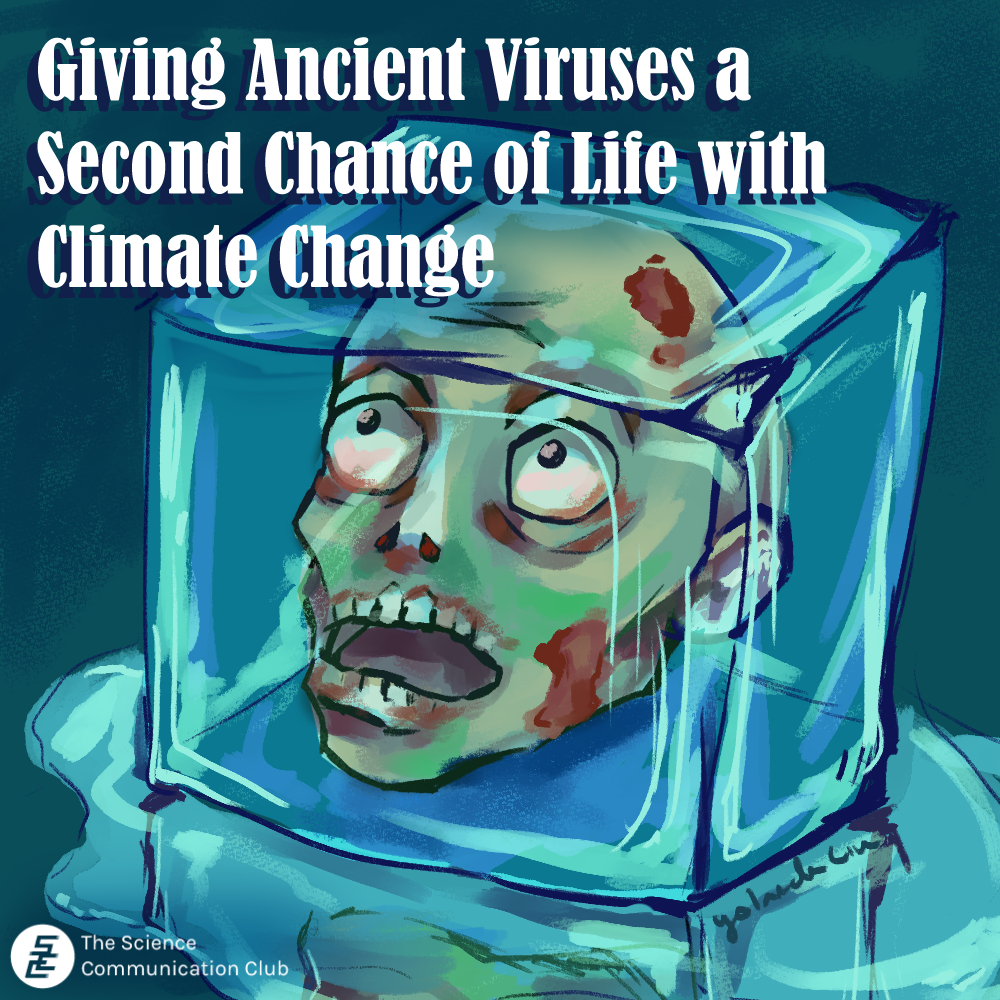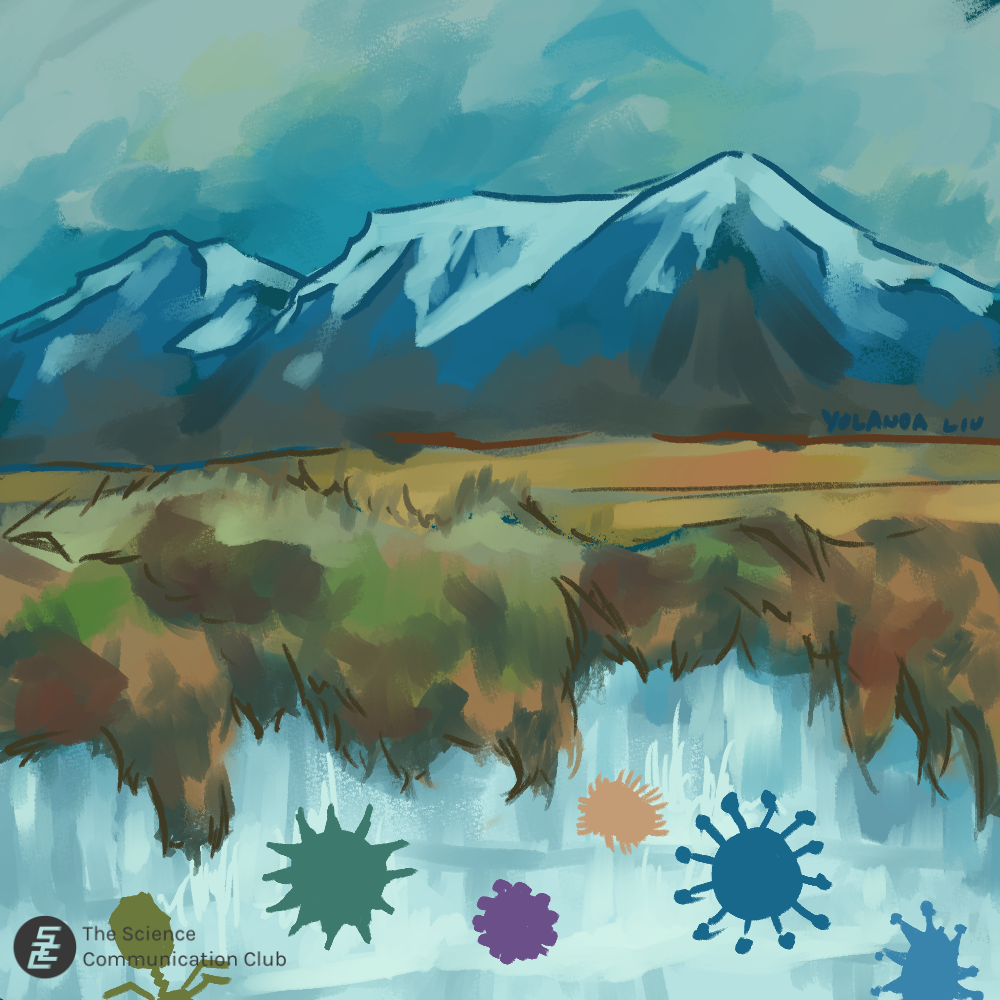
Written by Sabrina Zaidi
Illustrated by Yolanda Liu
We hear about zombies all the time in movies, books, and TV shows. They often start with a corpse coming back to life and passing a virus onto others, who then get infected and pass it onto more people— and suddenly you’ve got a zombie apocalypse on your hands. But what happens when the virus itself is a zombie, resurrected from its thousand-year underground slumber? While they might not be the bringers of the apocalypse, the release of ancient viruses that were previously frozen underground is a new and unprecedented consequence of climate change that has researchers wondering if they might cause issues for us in the future.
Although the impacts of climate change are widespread across the globe, the Arctic is facing the highest increase in temperature, rising at a rate of three times as much as the global annual average.1 As a result of the Arctic’s typically cold climate, permafrost makes up one quarter of the undersection of land area in the Northern Hemisphere.2 Permafrost is a type of ground material that generally lies underneath a layer of soil, remaining frozen for at least two years while the soil above it freezes and thaws annually with the seasons.3 The oldest segments of permafrost are over 600,000 years old, and can extend for up to a mile into the ground.3 With a name like permafrost, you would expect it to remain permanently frozen, however global warming due to climate change is beginning to challenge the permanence of permafrost. As temperatures rise in Canada, Alaska, and Siberia, increasingly large areas of permafrost are now thawing in many locations in the Arctic.3 Among the many consequences of thawing, permafrost that has been frozen since mammoths roamed the earth is starting to melt for the first time in thousands of years to uncover prehistoric marvels like fossils and other ancient remains.4 However, with the uncovering of ancient grounds and carcasses emerge ancient viruses that have previously been trapped in a frozen prison — many of which are still able to reproduce and live to see the modern world, unlike their deceased fossil counterparts.3
We’re already seeing a rise in potential health concerns because of thawing permafrost. Periodically, reindeer populations in the Arctic are faced with anthrax epidemics due to bacterial spores being released from ancient carcasses thawing out from under permafrost during extremely hot summers.2 Many studies have revealed that ancient permafrost has high bacterial diversity, with a large amount of these bacteria estimated to be alive today.2 Among these bacteria are ancestors of common harmful modern-day bacteria, including those that cause tuberculosis, leprosy, cholera, plague, and more.5 However, despite the potential for these bacterial ancestors to cause illness in humans, there is little concern for an epidemic as we already have antibiotics that can target the ancient bacteria’s molecular structures, which are the same as their modern counterparts.2

The more worrisome consequences of thawing permafrost surround viruses that lie beyond the scope of what we know. In situations where previously unknown ancient viruses are uncovered, we may not have the modern defences to fight them.2 Recently, a study revived multiple viruses, ranging between 27,000 and 48,500 years old, from Siberian permafrost samples for the first time. To determine if they were still infectious after all these years, scientists infected an amoeba with these ancient viral strains.2 They were found to successfully infect the amoeba cells, indicating that the viruses remained infectious.2
Now for the big question: Should we be concerned about a new pandemic? Not really — at least not for now. Currently, there has not been any direct evidence of human infection from pathogens released by thawing permafrost; however, scientists are still cautious about the potential for this to change. Antibiotic-resistant ancient bacteria have been found in deep levels of permafrost, and there are concerns that they might share genetic material with modern bacteria, creating new strains of antibiotic-resistant bacteria.6 As for viral pathogens, the amoeba infections from the experiments indicate that the viruses in the study, and potentially many other unknown viruses, have the ability to infect humans.2 Despite these implications, studies have yet to examine whether these viruses can survive conditions outside a controlled environment, and how long they can survive in these conditions without a host.2 It is vital that we take action against climate change, since the advancement of global warming will cause deeper levels of permafrost to continue to thaw, increasing the risk of a potentially harmful ancient virus becoming uncovered.2 However, studying the potential risks of such viruses while they’re still frozen can help us anticipate threats and improve mitigation efforts before it’s too late.
Sources
- The Arctic in a changing climate. Arctic Council. [accessed 2023 Feb 25]. https://arctic-council.org/explore/topics/climate/
- Alempic J-M, Lartigue A, Goncharov AE, Grosse G, Strauss J, Tikhonov AN, Fedorov AN, Poirot O, Legendre M, Santini S, et al. An update on eukaryotic viruses revived from ancient permafrost. Viruses. 2023;15(2):564. doi:10.3390/v15020564
- Perkins C. Will melting permafrost release ancient viruses and bacteria? BBC Science Focus Magazine. 2022 Jul 12 [accessed 2023 Feb 25]. https://www.sciencefocus.com/science/viruses-bacteria-in-permafrost/
- McQuillan L. Thawing arctic will reveal more mummified creatures and bring new risks for those still living | CBC news. CBCnews. 2022 Jul 13 [accessed 2023 Feb 25]. https://www.cbc.ca/news/science/thawing-arctic-mummified-species-risks-1.6518554
- El-Sayed A, Kamel M. 2020. Future threat from the past. Environmental Science and Pollution Research 28:1287–1291.
- Miner KR, D’Andrilli J, Mackelprang R, Edwards A, Malaska MJ, Waldrop MP, Miller CE. Emergent biogeochemical risks from Arctic permafrost degradation. Nature Climate Change. 2021;11(10):809–819. doi:10.1038/s41558-021-01162-y